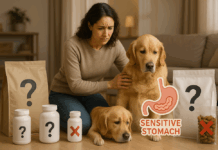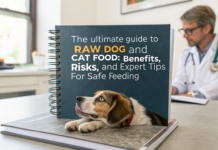Last Updated on November 21, 2024 by Dogs Vets
If you’re tired of cleaning up after your dog’s mealtime mess, a dog feeding mat might be exactly what you need. Dog feeding mats help keep food, water, and any spilled kibble in one spot, making mealtimes cleaner and easier for you and your pup. In this ultimate buying guide, we’ll go over everything you need to know to pick the perfect feeding mat for your dog.
Why Use a Dog Feeding Mat?
1. Keeps Floors Clean
Dogs can get pretty enthusiastic about eating, especially if you have a playful or larger breed. A feeding mat is designed to catch spills, preventing water and food bits from scattering all over your floors. It helps keep your space cleaner and reduces the need for constant sweeping or mopping.
2. Reduces Slipping and Skidding
Feeding mats often come with anti-slip features to prevent the mat—and the dog bowl—from moving around. This is especially useful for excitable dogs who tend to nudge their bowl while eating.
3. Protects Your Floor from Damage
Water spills and food crumbs can damage certain types of flooring, especially hardwood. A dog feeder mat provides a barrier between food and water spills and your flooring, helping prolong its life.
Types of Dog Feeding Mats
Silicone Dog Feeding Mats
Silicone is a popular material for dog feeding mats due to its durability, non-slip properties, and ease of cleaning. A dog silicone feeding mat is flexible, waterproof, and can often be cleaned with a simple rinse or wipe. Silicone mats also tend to stay in place, making them a top choice for energetic eaters.
Rubber Dog Feeding Mats
Rubber mats provide a solid, grippy surface that holds up well against moisture. They are durable and non-slip, ideal for dogs who tend to push their bowls around. Rubber mats are usually slightly thicker than silicone mats, which can add to the longevity of the product.
Plastic Dog Feeding Mats
Plastic mats are lightweight and generally less expensive than silicone or rubber options. They work well for small or medium-sized dogs, but they may not be as effective for larger, messier dogs since they can be easier to tip over or move.
Fabric Dog Feeding Mats
Fabric mats are soft and absorbent, which helps prevent water spills from reaching the floor. However, they may require more frequent washing and might not be as durable as silicone or rubber options.
Key Features to Consider When Buying a Dog Feeding Mat
1. Size
Choose a size that accommodates both your dog’s bowls and any potential mess around them. A mat should be big enough to contain spills from both food and water bowls but not so large that it takes up unnecessary space. For large dogs, consider feeding mats for dogs designed to hold larger feeder setups.
2. Material
Each material has pros and cons:
- Silicone: Durable, non-slip, easy to clean.
- Rubber: Grippy, thicker, and durable.
- Plastic: Lightweight and affordable.
- Fabric: Soft, absorbent, but may require frequent washing.
For messy eaters, consider a dog silicone feeding mat for ease of cleaning and long-term durability.
3. Non-Slip Bottom
A non-slip bottom is essential to keep the mat in place. Look for mats with rubberized or textured undersides that prevent sliding on tile, wood, or laminate floors. This will also prevent your dog from accidentally moving the mat and creating a bigger mess.
4. Raised Edges
Some feeding mats come with raised edges that help contain spills. This feature is useful for dogs who tend to splash water or scatter food while eating, as it prevents liquid and kibble from spilling onto the floor.
5. Ease of Cleaning
Feeding mats are made to handle spills, so they need to be easy to clean. Silicone and rubber mats are typically dishwasher-safe or can be quickly wiped down with a damp cloth. Fabric mats are often machine-washable, but they may require more frequent cleaning due to their absorbent nature.
Top Picks for Dog Feeding Mats
To make it easier to find the right mat for your dog, here are some of the best-rated dog feeding mats based on different needs:
1. Best Overall: Silicone Dog Feeding Mat
A dog silicone feeding mat is ideal for most pet owners. It’s non-slip, waterproof, and easy to clean. These mats are perfect for both food and water bowls and can handle spills and crumbs without hassle.
2. Best for Large Dogs: Oversized Rubber Feeding Mat
If you have a large dog or multiple pets, an oversized rubber mat may be the best option. These mats offer extra space, so they can hold multiple bowls and catch larger messes.
3. Best for Small Spaces: Compact Plastic Mat
For those with limited space, a compact plastic mat is a good option. These mats are lightweight, easy to store, and can be washed quickly. They’re best suited for smaller dogs who aren’t as messy.
4. Best for Extra Messy Eaters: High-Rim Feeding Mat
For dogs who leave a big mess, a high-rim mat can help. Raised edges keep water and food from spilling onto the floor, making cleanup easier. These mats are usually made from silicone or rubber, which makes cleaning up quick and simple.
How to Properly Clean and Maintain a Dog Feeding Mat
Keeping a feeding mat clean is essential for both hygiene and durability. Here’s a quick guide on how to care for different types of feeding mats:
1. Silicone and Rubber Mats
- Daily Cleaning: Wipe with a damp cloth or rinse under warm water to remove any food residue or water spills.
- Weekly Cleaning: Place the mat in the dishwasher or soak it in soapy water. Rinse thoroughly to remove any soap residue.
2. Fabric Mats
- Daily Cleaning: Shake out crumbs and wipe any spills as needed.
- Weekly Cleaning: Machine wash according to the care instructions. Allow it to air dry to maintain its absorbent properties.
3. Plastic Mats
- Daily Cleaning: Wipe with a damp cloth or rinse off any food spills.
- Weekly Cleaning: Wash with warm, soapy water and let air dry. Avoid high heat, as it can warp plastic mats.
Dog Feeding Mat Safety Tips
Here are some tips to make sure you’re using your dog feeding mat safely:
- Secure the Mat on the Floor: Make sure the mat is laid flat and won’t slip or slide underfoot. This is especially important if your dog is prone to running toward their food.
- Keep the Mat Clean: Leftover food and water can attract bacteria or mold, which could affect your dog’s health. Clean the mat regularly to prevent any hygiene issues.
- Check for Wear and Tear: Feeding mats can wear out over time, especially fabric ones. If you notice any cracks, holes, or fraying, it may be time to replace it to keep your floor protected and your pet safe.
- Use Pet-Safe Cleaning Products: When washing your dog’s feeding mat, use pet-safe, non-toxic cleaning products. Any residue left from harsh cleaners could potentially harm your dog if they come in contact with it.
Frequently Asked Questions
What size dog feeding mat should I get?
The size of the mat depends on the size of your dog and the bowls you’re using. A larger dog with bigger bowls will need a larger mat. Make sure the mat has enough space to hold both food and water bowls with extra room around the edges to catch any spills.
Are silicone feeding mats safe for dogs?
Yes, dog silicone feeding mats are generally safe and made from food-grade silicone. They’re non-toxic and can be used for both food and water. However, always check that the mat is BPA-free and made from quality silicone.
Can I put a dog feeding mat in the dishwasher?
Many silicone and rubber feeding mats are dishwasher-safe, which makes them easy to clean. Just double-check the product instructions before placing it in the dishwasher.
Do feeding mats prevent water from getting on the floor?
Yes, feeding mats, especially those with raised edges, help contain water spills. While they won’t keep every drop off the floor, they significantly reduce the mess compared to having no mat.
How often should I replace a dog feeding mat?
Feeding mats should be replaced when they show signs of wear and tear, like cracks or fraying. For most durable mats, replacement may only be necessary every couple of years.
Final Thoughts: Choosing the Right Dog Feeding Mat for Your Needs
A dog feeding mat can make mealtime a cleaner, more enjoyable experience for both you and your pet. Whether you choose a dog silicone feeding mat for durability, a rubber mat for extra grip, or a high-rim mat for maximum mess control, you’ll find that investing in good feeding mats for dogs saves time and effort in cleaning up after your dog.
Take the time to consider the size, material, and any special features like raised edges or non-slip bottoms that would work best for your pet’s specific eating style. With the right dog feeder mat, you can keep your floors clean and make mealtime stress-free!
















